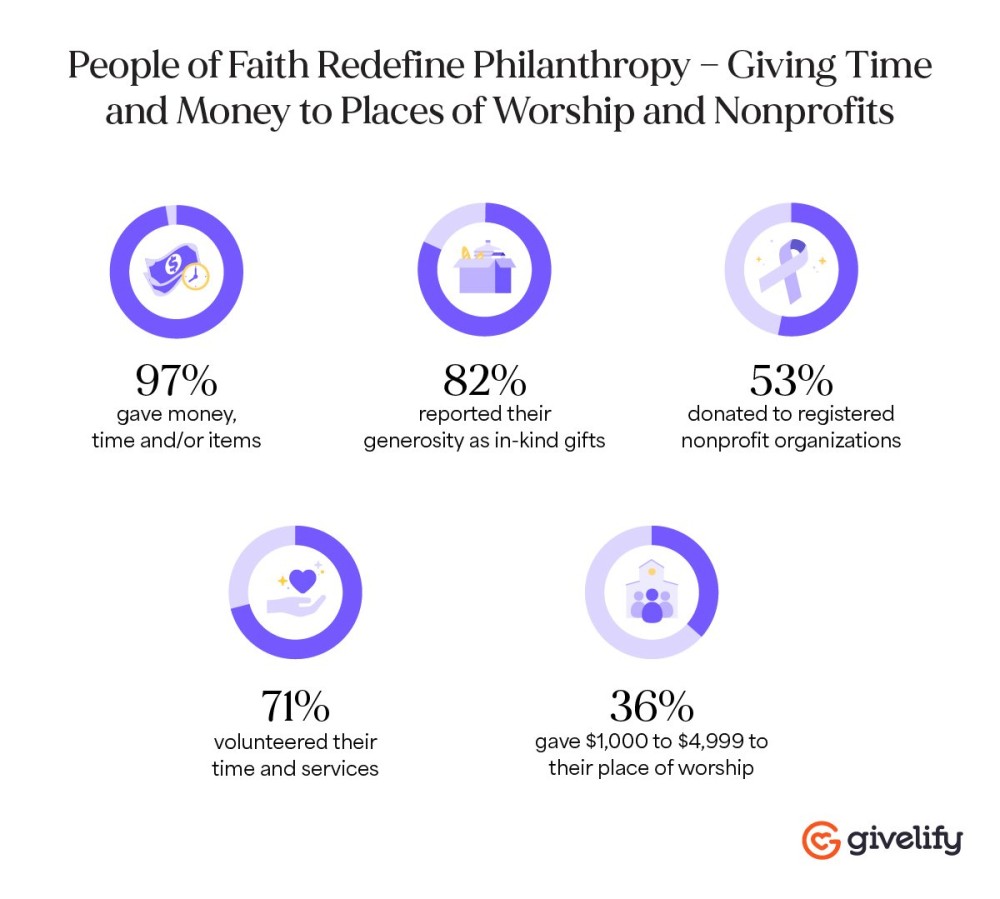Religious donors keep giving to houses of worship and beyond amid inflation

(Graphic courtesy of Givelify)
Religious people in the US are continuing to give to their houses of worship—and to other causes—with money and in-kind donations despite rising costs for daily living, a new report shows.
More than 8 in 10 (81 percent) faith-based givers who donated money in 2023 gave funds
to houses of worship, and 60 percent gave $1,000 or more, according to Giving in Faith: Exploring Key Trends in Religious Giving, a joint 2024 report from Givelify, a mobile and online app, and Indiana University’s Lake Institute on Faith & Giving.
Most religious donors (81 percent) gave the same amount of money (or more) to their congregations in 2023 as in 2022.
A similar percentage of religious donors (82 percent) reported that they made in-kind gifts, such as physical items to places of worship, registered nonprofits, informal community group, or directly to people who had a need.
By viewing the philanthropy of people of faith beyond just their congregations, researchers have gained a wider sense of how much and why they share their money and their time, said Wale Mafolasire, founder and CEO of Givelify, an Indianapolis-based company that launched in 2013.
For example, 48 percent of faith-based givers who made donations gave money directly to friends, neighbors, relatives, and others in need. Describing those direct monetary gifts, 70 percent reported donating to family members, 61 percent to friends, and 60 percent to strangers.
“When we expand that definition to include not just what they’re giving to their place of worship, but also what they’re giving in kind and to other members of the community and to their members, we’re seeing that people of faith are probably the most generous in the United States of America,” said Mafolasire, whose company runs an app used by congregants and others to make donations to nonprofit organizations.
The report’s findings are based on responses from 2,000 religious Americans and 980 faith leaders in the country. The vast majority of the respondents were Christians.
The research included an oversample of African American and Black faith givers in order to gauge perceptions on the value of houses of worship to their communities. Forty-four percent of the respondents who were people of faith were Black or African, while 48 percent were White.
The racial composition of the faith leaders’ congregations were 45 percent Black or African, 34 percent White or European, and 19 percent multiracial (or with no more than 80 percent of a single race or ethnicity).
“There’s an increase in the number of places of worship, especially within the African American segment, that are taking a more active role of providing safety net programs to members of their congregations, and also nonmembers or members of the local community,” said Mafolasire.
Black people comprise about 80 percent of Givelify app users, and about 80 percent of congregations using Givelify are predominantly Black.
According to the faith leaders surveyed for the report, predominantly Black congregations were more likely than mostly White congregations to offer elderly support services (60 percent vs. 46 percent), outreach programs for people in prison (35 percent vs. 17 percent), and supplemental educational support, such as GED classes and tutoring (46 percent vs. 29 percent).
Black faith leaders also were more likely to say they teach their congregants to give money, items, and time to their congregation (84 percent vs. 77 percent) and the local community (67% percent vs. 57 percent).
Close to all (97 percent) houses of worship offered at least one outreach program to their communities, an increase from 90 percent of faith leaders who reported the same in the 2022 Giving in Faith report released by the two organizations. These efforts included support with money, goods, volunteers, and physical space.
Overall, almost all faith leaders (99 percent) reported that they intended to increase or maintain their community outreach work in 2024.
Despite higher prices for groceries, housing, and other regular expenses, the amount of giving to houses of worship remained stable, with an average gift amount of $125, the same figure as in the joint 2022 report.
“It’s oftentimes the last thing that many people of faith would think about cutting,” said David P. King, director of the Lake Institute on Faith & Giving. He said giving to houses of worship is often considered to be a basic expense rather than a “luxury good,” as some other forms of charitable giving might be viewed.
The research in the report is based on a survey conducted in August and September 2023.
The 980 faith leaders included 606 in a random sample of congregations contacted by Givelify and 374 who responded either through e-newsletters or via a marketing research firm. The estimated margin of error was about plus or minus 3 percentage points.
In addition, 1,000 Givelify customers and 1,000 respondents to the academic survey platform Prolific completed the survey, with an estimated margin of error of about plus or minus 2 percentage points. —Religion News Service




